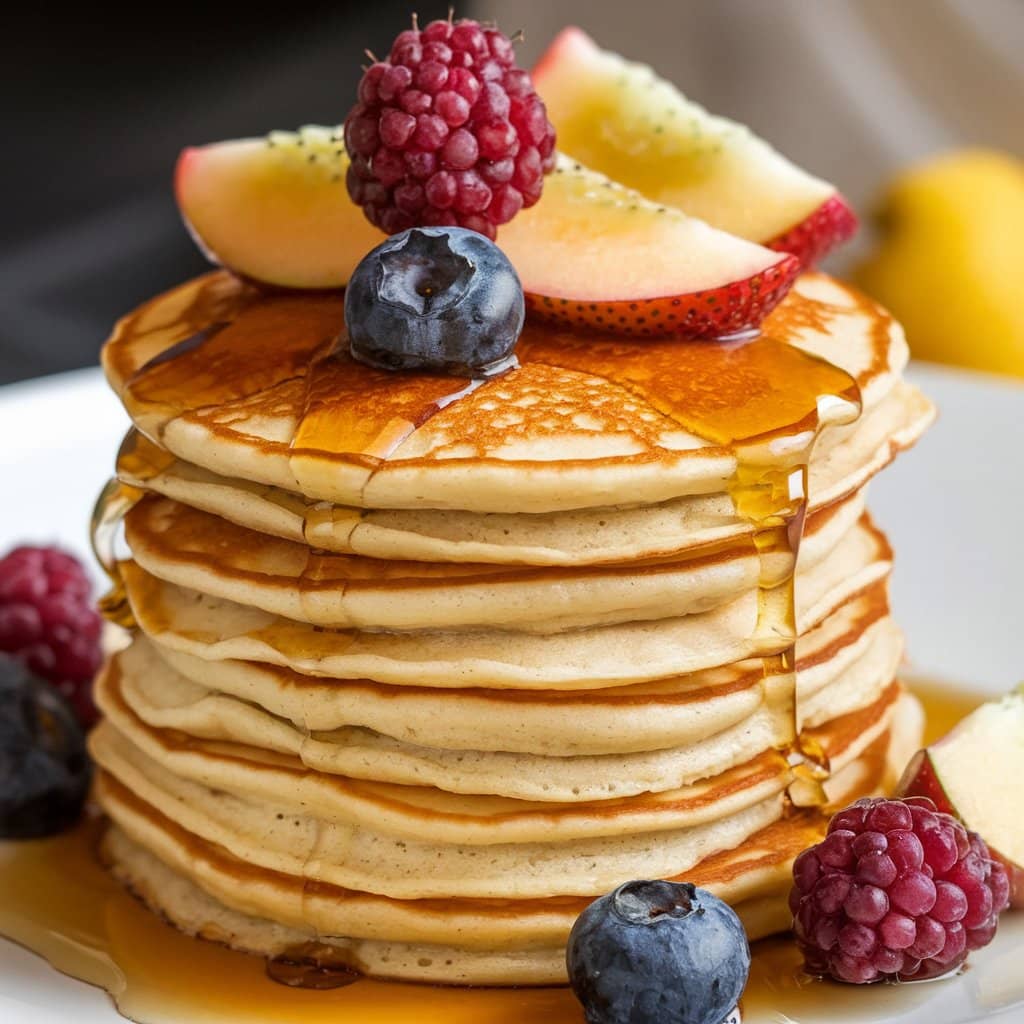What Can I Use Instead of Egg in Pancakes? Eggs are a common ingredient in pancake recipes, playing a crucial role in binding, adding moisture, and creating that light, fluffy texture we all love. But what if you’re out of eggs, have an allergy, or follow a vegan diet? Can you still make delicious pancakes without eggs? The answer is a resounding yes!
In this comprehensive guide, we’ll explore the best egg substitutes for pancakes, explain how they work, and provide practical tips for achieving perfect pancakes every time. Whether you’re looking for plant-based options, allergy-friendly solutions, or simple pantry swaps, you’ll find the perfect egg replacement for your next pancake breakfast.
Table of Contents
Why Are Eggs Used in Pancakes?
Eggs play multiple roles in pancake recipes, contributing to their signature taste and texture. But what can I use instead of egg in pancakes if I want similar results? Eggs are essential for creating fluffy and moist pancakes, but substitutes can work just as well. Let’s take a closer look at how eggs function in pancakes and the best alternatives you can use.
1. Binding Agent – Why Do Pancakes Need Eggs?
Eggs help bind pancake batter together, ensuring the ingredients don’t separate during cooking. They create a cohesive batter that holds its shape when poured onto the griddle. When looking for egg alternatives for pancakes, flaxseed, chia seeds, or commercial egg replacers can effectively replicate this binding function.
2. Moisture Provider – What Can I Use Instead of Egg in Pancakes for Softness?
Eggs add essential moisture to pancake batter, making the pancakes soft and tender. However, if you’re making pancake recipes without eggs, it’s important to use substitutes that provide similar hydration. Consider using applesauce, mashed bananas, or plant-based yogurt. Not only do these egg-free pancake substitutes keep the batter moist, but they also enhance the overall flavor and texture. That’s why choosing the best egg substitute in pancakes is crucial for achieving great results.
3. Leavening Agent – Do Eggs Make Pancakes Fluffy?
Eggs help pancakes rise by trapping air during the mixing process. This creates light, fluffy pancakes with a soft, airy texture. If you’re making vegan pancake egg replacements, substitutes like baking powder and vinegar or commercial egg replacers are ideal for achieving the same leavening effect. By using the right egg alternative for pancakes, you can still enjoy a stack of fluffy, delicious pancakes without compromise.
Best Egg Substitutes for Pancakes
There are many effective egg substitutes for pancakes, each offering unique benefits. Depending on what you have on hand and your dietary preferences, some options may work better than others. For instance, fruit-based substitutes add natural sweetness, while starch-based options provide a more neutral taste. Additionally, commercial egg replacers are convenient and easy to use. With that in mind, let’s explore fruit-based, dairy-free, starch-based, and commercial egg replacers that work well in pancake recipes. By understanding how each substitute functions, you can choose the best one for your next pancake breakfast.
Fruit-Based Egg Substitutes for Pancakes
Fruits like bananas, apples, and pumpkin can act as natural egg substitutes due to their binding and moisture-adding properties.
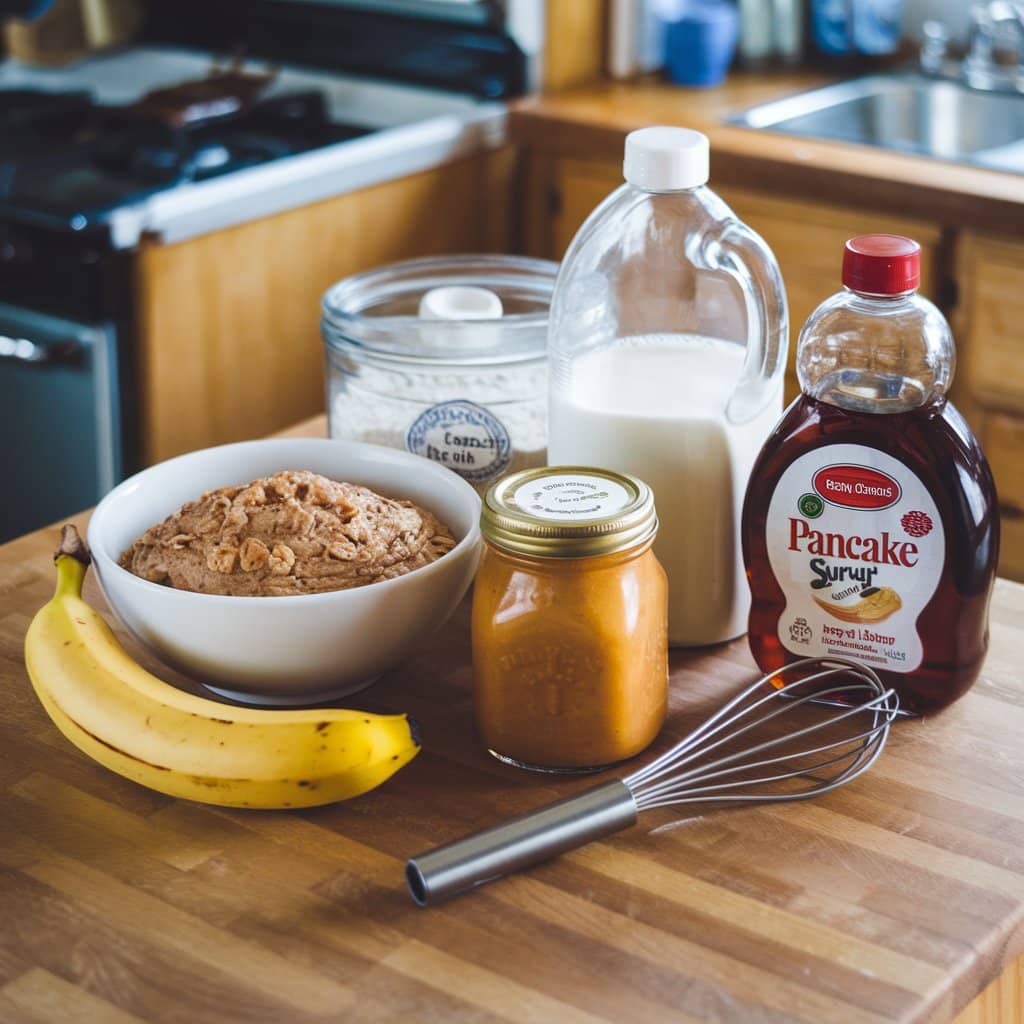
1. Mashed Bananas
- How It Works: Bananas are rich in moisture and natural sugars. They help bind the pancake batter while adding a hint of sweetness.
- How to Use: Substitute 1 egg with 1/2 a mashed banana (about 1/4 cup).
- Best For: Sweet or dessert-style pancakes like chocolate chip or banana pancakes.
2. Unsweetened Applesauce
- How It Works: Applesauce is an excellent egg alternative that keeps pancakes moist and tender.
- How to Use: Use 1/4 cup of unsweetened applesauce per egg. Reduce added sugar in the recipe if needed.
- Best For: Classic pancakes, cinnamon-flavored pancakes, or healthier breakfast options.
3. Pumpkin Puree
- How It Works: Pumpkin puree provides moisture and a slight earthy sweetness, making pancakes rich and soft.
- How to Use: Replace 1 egg with 1/4 cup of pumpkin puree.
- Best For: Fall-inspired pancakes like pumpkin spice or cinnamon pancakes.
Dairy-Free Liquid Egg Substitutes
For a creamy, smooth texture without eggs, consider using dairy-free alternatives like yogurt, silken tofu, or nut butters. In particular, plant-based yogurt adds moisture and richness, while silken tofu provides a neutral taste with excellent binding properties. Similarly, nut butters such as almond or peanut butter offer both binding power and a delicious, nutty flavor. As a result, these substitutes can help create pancakes that are soft, tender, and full of flavor.
4. Plant-Based Liquid Substitutes
- How It Works: Yogurt adds moisture and tenderness, making pancakes light and soft.
- How to Use: Use 1/4 cup of unsweetened plant-based yogurt per egg.
- Best For: Pancakes that need extra fluffiness and a slightly tangy taste.
5. Silken Tofu
- How It Works: Silken tofu is neutral in flavor and works well as a binding agent.
- How to Use: Blend 1/4 cup of silken tofu until smooth to replace 1 egg.
- Best For: Protein-rich pancakes or allergy-friendly recipes.
6. Nut Butters (Peanut, Almond)
- How It Works: Nut butters act as a binder while adding a rich, nutty flavor.
- How to Use: Use 3 tablespoons of peanut, almond, or cashew butter per egg.
- Best For: Pancakes with chocolate chips or fruit toppings.
Starch-Based and Powder Substitutes
Starches are excellent for providing structure and stability in egg-free pancakes.
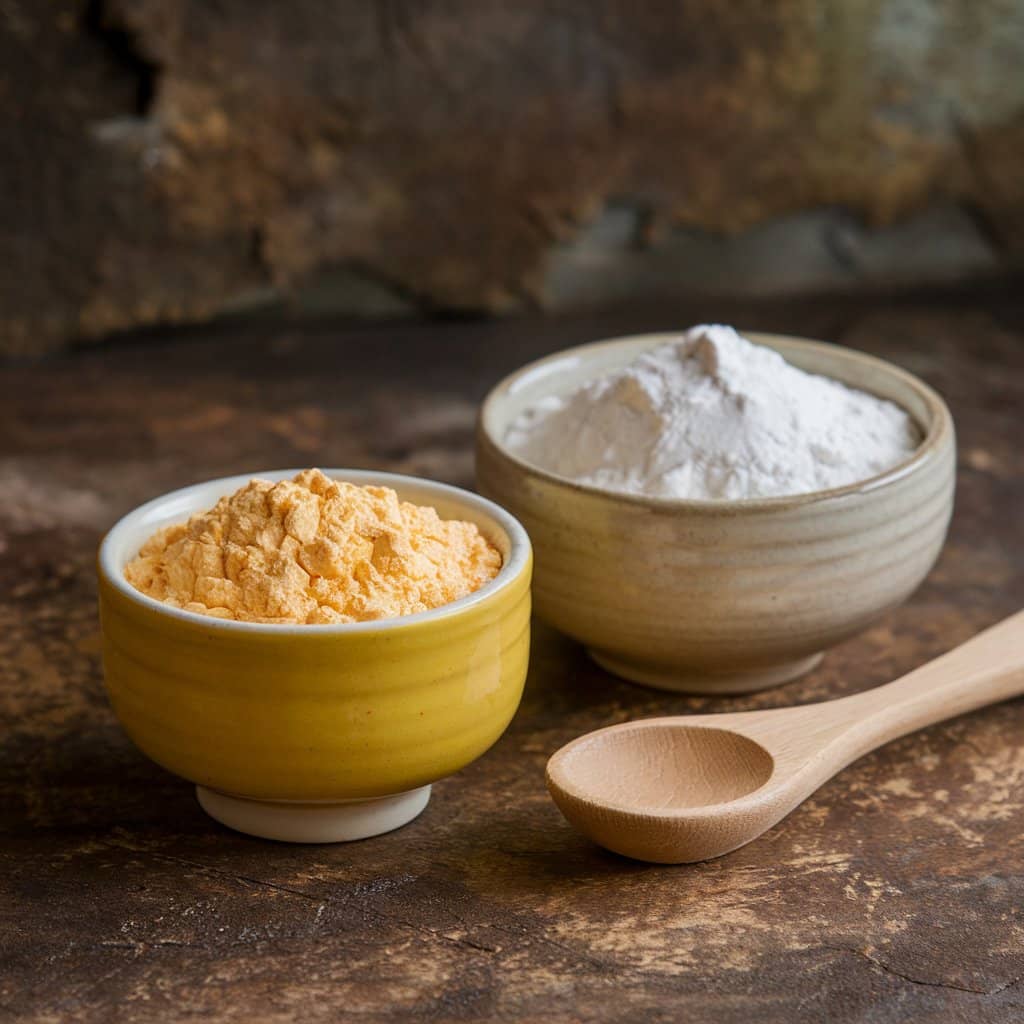
7. Cornstarch or Arrowroot Powder
- How It Works: Starches create a gel-like consistency when mixed with water, providing binding power.
- How to Use: Mix 2 tablespoons of cornstarch or arrowroot powder with 3 tablespoons of water per egg.
- Best For: Light and fluffy pancakes with a neutral taste.
8. Potato Starch
- How It Works: Potato starch thickens the batter and helps pancakes rise during cooking.
- How to Use: Replace 1 egg with 2 tablespoons of potato starch mixed with water.
- Best For: Gluten-free and allergy-friendly pancakes.
Commercial Egg Replacers
If you prefer convenience, commercial egg replacers are readily available and formulated to mimic eggs in baking. Typically, these products are made from a blend of starches and leavening agents, ensuring similar binding and rising effects. Moreover, they are easy to use—just follow the package instructions for the right egg replacement ratio. As a bonus, commercial egg replacers are shelf-stable, making them a practical choice for those who frequently bake egg-free recipes. Therefore, they are an excellent option for creating consistent, fluffy pancakes with minimal effort.
9. Flaxseed Meal
- How It Works: Flaxseed becomes gel-like when mixed with water, offering excellent binding power.
- How to Use: Combine 1 tablespoon of flaxseed meal with 3 tablespoons of water for each egg. Let it sit for 5-10 minutes before using.
- Best For: Hearty, whole-grain pancakes with a nutty flavor.
10. Chia Seeds
- How It Works: Chia seeds swell in water, forming a thick gel similar to flaxseed.
- How to Use: Mix 1 tablespoon of chia seeds with 3 tablespoons of water and let it rest until thickened.
- Best For: Fiber-rich and nutrient-dense pancakes.
11. Baking Powder and Vinegar
- How It Works: This combination creates a chemical reaction that makes pancakes rise.
- How to Use: Mix 1 teaspoon of baking powder with 1 tablespoon of vinegar and 2 tablespoons of water.
- Best For: Extra fluffy, diner-style pancakes.
How to Use Egg Substitutes in Pancakes
Replacing eggs in pancakes isn’t just about choosing a substitute—it’s about using it correctly. Each alternative has unique properties, so knowing how to adjust measurements and mixing techniques is key to pancake perfection.
Measuring Properly
Accurate measurement ensures your pancakes turn out as expected. Here’s how to measure common substitutes:
- Fruits (Banana, Applesauce, Pumpkin Puree): Use 1/4 cup to replace 1 egg. Mash or blend fruits for smooth consistency.
- Starches (Cornstarch, Arrowroot, Potato Starch): Mix 2 tablespoons with 3 tablespoons of water to create a thick paste.
- Liquids (Yogurt, Silken Tofu): Use 1/4 cup per egg, blending if needed for smoothness.
- Seeds (Flaxseed or Chia Seeds): Mix 1 tablespoon of seeds with 3 tablespoons of water, allowing time to gel before adding.
Mixing Techniques
Proper mixing ensures pancakes have the right texture:
- Step 1: Combine Dry Ingredients First
Whisk together flour, baking powder, salt, and sugar. This helps distribute leavening agents evenly. - Step 2: Prepare the Egg Substitute
Prepare the egg replacement separately to ensure proper texture before adding it to the batter. - Step 3: Mix Gently
Slowly combine wet and dry ingredients. Overmixing can make pancakes tough. Aim for a lumpy batter for fluffier pancakes.
Cooking Adjustments and Pancake Texture
Cooking times and methods may need slight adjustments when using egg substitutes.
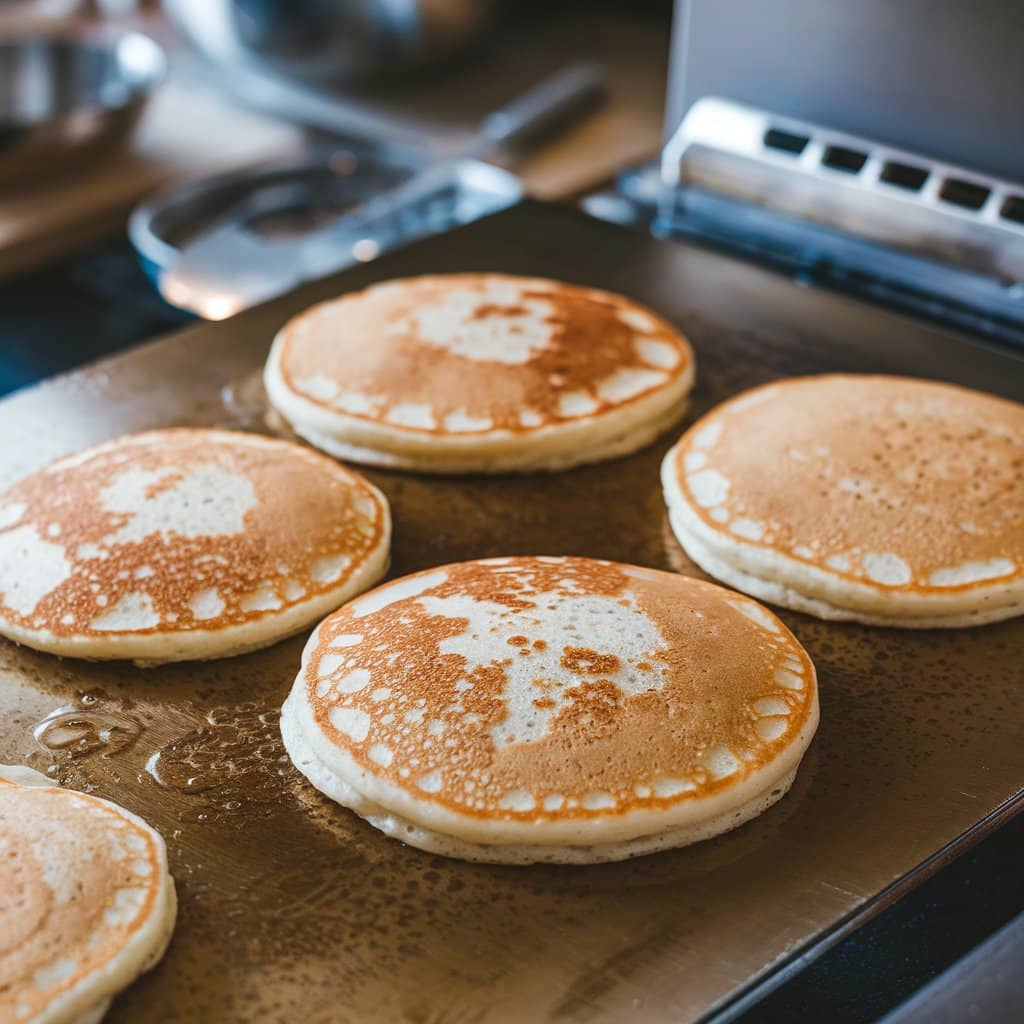
- Preheat the Griddle or Pan: A hot surface ensures even cooking and prevents sticking. Use medium heat to avoid burning.
- Grease the Pan Well: Egg-free pancakes can stick more easily, so use a non-stick spray or a light coating of oil.
- Flip at the Right Time: Watch for bubbles forming on the surface before flipping. If the batter is thicker due to a starch-based substitute, wait a few extra seconds.
Recipes Using Egg Substitutes
To showcase how effective egg replacements can be, here are three simple and delicious pancake recipes. Whether you’re looking for a vegan option, a fiber-rich twist, or a gluten-free alternative, these recipes have you covered.
Vegan Banana Pancakes Recipe
Ingredients:
- 1 cup all-purpose flour
- 1 tablespoon baking powder
- 1 tablespoon sugar
- 1/2 teaspoon salt
- 1/2 cup mashed banana (egg substitute)
- 1 cup plant-based milk
- 2 tablespoons melted coconut oil
- 1 teaspoon vanilla extract
Instructions:
- In a large bowl, combine the dry ingredients: flour, baking powder, sugar, and salt.
- In another bowl, whisk together the mashed banana, plant-based milk, melted coconut oil, and vanilla extract.
- Gradually mix the wet ingredients into the dry ingredients. Avoid overmixing to keep the pancakes light.
- Preheat a non-stick pan over medium heat.
- Pour 1/4 cup of batter onto the pan for each pancake. Cook until bubbles form on the surface, then flip and cook for another minute or until golden.
- Serve with maple syrup, fresh fruit, or your favorite toppings.
Flaxseed Pancakes Recipe
Ingredients:
- 1 cup whole-wheat flour
- 1 tablespoon ground flaxseed (egg substitute)
- 2 tablespoons water
- 1 tablespoon baking powder
- 1 tablespoon sugar
- 1/2 teaspoon cinnamon
- 1 cup almond milk
- 2 tablespoons vegetable oil
Instructions:
- In a small bowl, mix the flaxseed and water. Let it sit for 5-10 minutes until it forms a gel-like consistency.
- In a large bowl, whisk together the whole-wheat flour, baking powder, sugar, and cinnamon.
- Add the almond milk, vegetable oil, and flaxseed mixture to the dry ingredients. Stir gently until just combined.
- Heat a non-stick skillet over medium heat.
- Pour 1/4 cup of batter onto the skillet for each pancake. Cook until bubbles form on the surface, then flip and cook until golden brown.
- Serve with nut butter, fruit compote, or a drizzle of syrup.
Gluten-Free Apple Pancakes Recipe
Ingredients:
- 1 cup gluten-free flour blend
- 1/4 cup unsweetened applesauce (egg substitute)
- 1 tablespoon baking powder
- 1 teaspoon ground cinnamon
- 1/2 teaspoon salt
- 1 cup oat milk
- 1 tablespoon maple syrup
Instructions:
- In a mixing bowl, whisk together the gluten-free flour, baking powder, cinnamon, and salt.
- Add the applesauce, oat milk, and maple syrup. Stir until well combined but do not overmix.
- Lightly grease a skillet and heat it over medium heat.
- Pour 1/4 cup of batter onto the skillet for each pancake. Cook until bubbles appear, then flip and cook for an additional minute or until browned.
- Serve warm with sliced apples, cinnamon syrup, or a dusting of powdered sugar.
Egg-Free Pancake Troubleshooting
Even with the best egg substitutes, pancakes can occasionally go wrong. Here’s how to fix common problems when making egg-free pancakes:
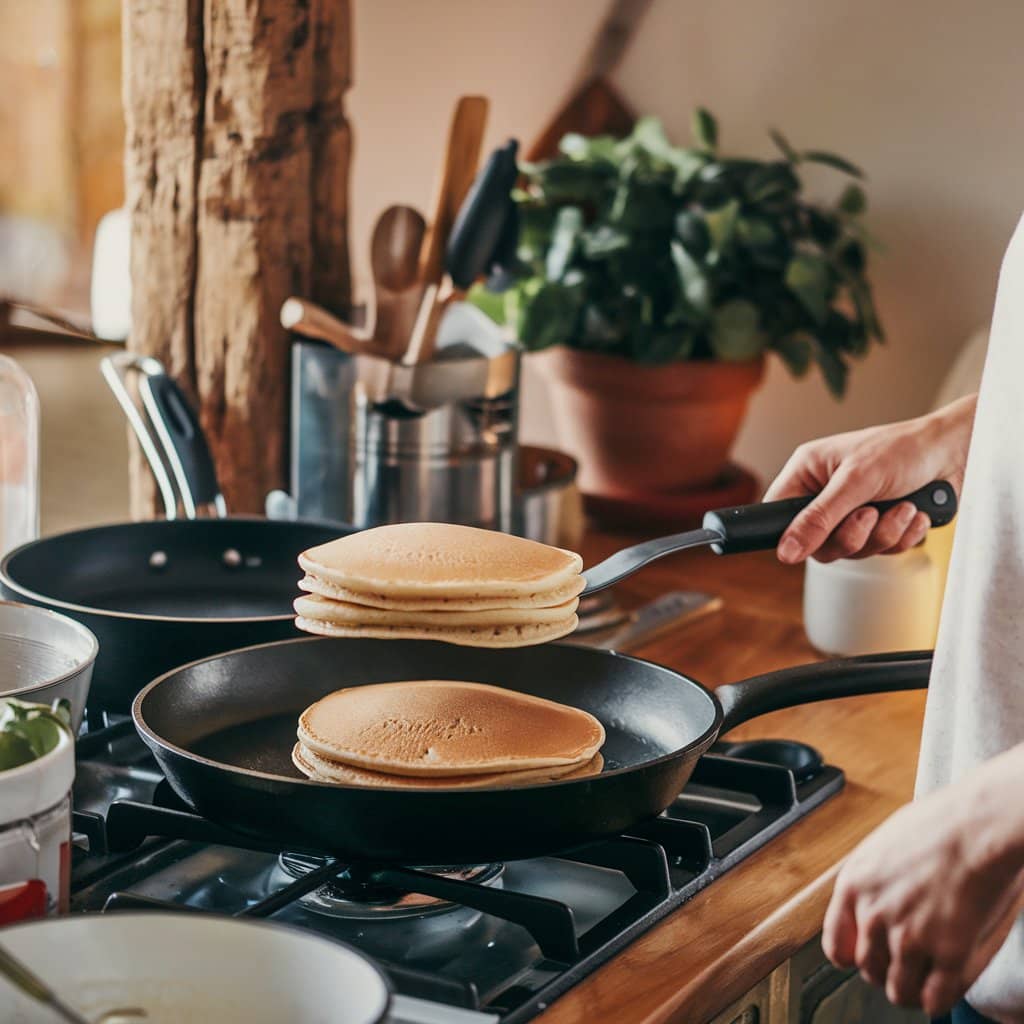
Why Pancakes May Be Too Dense
Causes:
- Using too much starch-based substitute like cornstarch or arrowroot.
- Batter is too thick due to insufficient liquid.
Fix:
- Adjust the batter by adding more plant-based milk or water.
- Avoid overmixing, which activates gluten and creates dense pancakes.
Why Pancakes May Be Too Flat
Causes:
- Not enough leavening agent (baking powder or baking soda).
- Skipping the vinegar-baking powder combination.
Fix:
- Add 1 teaspoon of baking powder per cup of flour.
- For extra lift, mix 1 tablespoon of vinegar or lemon juice with 1 teaspoon of baking powder.
Why Pancakes May Stick to the Pan
Causes:
- Insufficient oil or non-stick spray.
- Pan not hot enough before pouring the batter.
Fix:
- Preheat the pan properly before cooking.
- Lightly grease the pan after every pancake batch.
How to Fix Runny Batter
Causes:
- Too much liquid added when using fruit-based substitutes like bananas or applesauce.
Fix:
- Add extra flour, 1 tablespoon at a time, until the batter reaches a thick, spoonable consistency.
Adjusting Sweetness and Flavor
If using naturally sweet substitutes like bananas or applesauce, reduce the sugar in the recipe to prevent overly sweet pancakes. You can also adjust flavor by adding cinnamon, vanilla extract, or nutmeg for more depth.
Vegan and Allergy-Friendly Pancakes
Egg-free pancakes are ideal for people with dietary restrictions. Here are tips for ensuring your pancakes are not only egg-free but also vegan, gluten-free, and allergy-friendly:
Making Vegan Pancakes
- Use plant-based milk like almond, soy, or oat milk.
- Replace butter with coconut oil, vegan margarine, or olive oil.
- Choose egg substitutes like flaxseed meal, chia seeds, or applesauce.
Gluten-Free Pancakes
- Use gluten-free flour blends made from rice flour, almond flour, or oat flour.
- Add xanthan gum for better structure if your flour blend doesn’t include it.
- Ensure baking powder and other ingredients are certified gluten-free.
Nut-Free and Soy-Free Options
- Choose rice milk or coconut milk for nut-free alternatives.
- Avoid tofu or soy-based yogurts if you have a soy allergy.
Health Benefits of Egg-Free Pancakes
Egg-free pancakes can be a healthier option depending on the ingredients used:
- Lower Cholesterol: Substituting eggs reduces cholesterol, making pancakes heart-healthier.
- Higher Fiber Content: Ingredients like flaxseed meal and applesauce increase fiber intake.
- Reduced Allergens: Egg-free pancakes are safer for people with egg allergies or dietary restrictions.
Frequently Asked Questions (FAQs)
1. Can I Skip Eggs Entirely in Pancakes?
Yes, you can skip eggs entirely by using suitable substitutes like bananas, applesauce, or baking powder with vinegar.
2. What Substitute Is Best for Fluffy Pancakes?
The baking powder and vinegar combination is the best for extra fluffy pancakes due to its leavening effect.
3. Do Egg Substitutes Affect Taste?
Most substitutes like flaxseed or baking powder have a neutral taste, while bananas and applesauce add a mild sweetness.
4. Can I Use Milk Instead of Eggs?
Milk cannot replace eggs because it lacks the binding and leavening properties. However, plant-based milk can be used alongside other substitutes.
5. Can I Use Oil Instead of Eggs?
Oil alone won’t provide binding, but when combined with baking powder or fruit puree, it can work well in pancakes.
6. Do Egg-Free Pancakes Freeze Well?
Yes, egg-free pancakes freeze well. Let them cool completely, then freeze in an airtight container for up to three months. Reheat in the toaster or microwave.
Conclusion: What Can I Use Instead of Egg in Pancakes?
Making pancakes without eggs is simple with the right substitutes and techniques. Whether you prefer fruit-based, starch-based, or commercial egg replacers, you can enjoy fluffy, delicious pancakes without compromising taste or texture. Experiment with different substitutes to find what works best for you and enjoy hassle-free, egg-free pancakes anytime!

